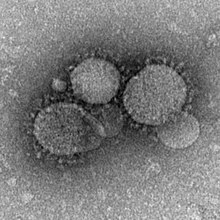
Back فيروس كورونا المرتبط بمتلازمة الشرق الأوسط التنفسية Arabic فيروس كورونا الشرق الاوسط ARZ মার্স করোনাভাইরাস Bengali/Bangla MERS coronavirus Catalan MERS-CoV Danish MERS-CoV German Κορονοϊός του αναπνευστικού συνδρόμου της Μέσης Ανατολής Greek Coronavirus del síndrome respiratorio de Oriente Medio Spanish MERS-CoV Estonian کروناویروس مرس Persian
| Betacoronavirus cameli | |
|---|---|

| |
| MERS-CoV particles as seen by negative stain electron microscopy. Virions contain characteristic club-like projections emanating from the viral membrane. | |
| Virus classification | |
| (unranked): | Virus |
| Realm: | Riboviria |
| Kingdom: | Orthornavirae |
| Phylum: | Pisuviricota |
| Class: | Pisoniviricetes |
| Order: | Nidovirales |
| Family: | Coronaviridae |
| Genus: | Betacoronavirus |
| Subgenus: | Merbecovirus |
| Species: | Betacoronavirus cameli
|
| Synonyms | |
| |
Betacoronavirus cameli [1] ( also known as Middle East respiratory syndrome–related coronavirus abbreviated as MERS-CoV),[2] or EMC/2012 (HCoV-EMC/2012), is the virus that causes Middle East respiratory syndrome (MERS).[3][4] It is a species of coronavirus which infects humans, bats, and camels.[5] The infecting virus is an enveloped, positive-sense, single-stranded RNA virus which enters its host cell by binding to the DPP4 receptor.[6] The species is a member of the genus Betacoronavirus and subgenus Merbecovirus.[7][5]
Initially called simply novel coronavirus or nCoV, with the provisional names 2012 novel coronavirus (2012-nCoV) and human coronavirus 2012 (HCoV-12 or hCoV-12), it was first reported in June 2012 after genome sequencing of a virus isolated from sputum samples from a person who fell ill in a 2012 outbreak of a new flu-like respiratory illness. By July 2015, MERS-CoV cases had been reported in over 21 countries, in Europe, North America and Asia as well as the Middle East. MERS-CoV is one of several viruses identified by the World Health Organization (WHO) as a likely cause of a future epidemic. They list it for urgent research and development.[8][9]
- ^ "Taxon Details | ICTV". International Committee on Taxonomy of Viruses (ICTV). Retrieved 25 July 2024.
- ^ de Groot RJ, Baker SC, Baric RS, Brown CS, Drosten C, Enjuanes L, Fouchier RA, Galiano M, Gorbalenya AE, Memish ZA, Perlman S, Poon LL, Snijder EJ, Stephens GM, Woo PC, Zaki AM, Zambon M, Ziebuhr J (July 2013). "Middle East respiratory syndrome coronavirus (MERS-CoV): announcement of the Coronavirus Study Group". Journal of Virology. 87 (14): 7790–2. doi:10.1128/JVI.01244-13. PMC 3700179. PMID 23678167.
- ^ "Middle East respiratory syndrome coronavirus (MERS-CoV)". www.who.int. Archived from the original on 18 April 2018. Retrieved 15 April 2020.
- ^ Zumla A, Hui DS, Perlman S (September 2015). "Middle East respiratory syndrome". Lancet. 386 (9997): 995–1007. doi:10.1016/S0140-6736(15)60454-8. PMC 4721578. PMID 26049252.
- ^ a b Wong AC, Li X, Lau SK, Woo PC (20 February 2019). "Global Epidemiology of Bat Coronaviruses". Viruses. 11 (2): 174. doi:10.3390/v11020174. PMC 6409556. PMID 30791586.
See Figure 3.
- ^ Fehr AR, Perlman S (2015). "Coronaviruses: An Overview of Their Replication and Pathogenesis". In Maier HJ, Bickerton E, Britton P (eds.). Coronaviruses. Methods in Molecular Biology. Vol. 1282. Springer. pp. 1–23. doi:10.1007/978-1-4939-2438-7_1. ISBN 978-1-4939-2438-7. PMC 4369385. PMID 25720466.
See Table 1.
- ^ "Virus Taxonomy: 2018 Release". International Committee on Taxonomy of Viruses (ICTV). October 2018. Archived from the original on 20 March 2020. Retrieved 13 January 2019.
- ^ Kieny MP. "After Ebola, a Blueprint Emerges to Jump-Start R&D". Scientific American Blog Network. Archived from the original on 20 December 2016. Retrieved 13 December 2016.
- ^ "LIST OF PATHOGENS". World Health Organization. Archived from the original on 20 December 2016. Retrieved 13 December 2016.